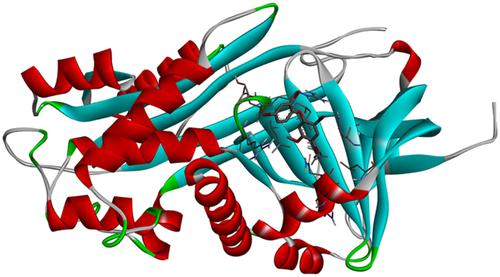当前位置:
X-MOL 学术
›
Luminescence
›
论文详情
Our official English website, www.x-mol.net, welcomes your
feedback! (Note: you will need to create a separate account there.)
Exploring the toxic effects and mechanism of methoxylated polybrominated diphenyl ethers (MeO-PBDEs) on thyroxine-binding globulin (TBG): Synergy between spectroscopic and computations
Luminescence ( IF 3.2 ) Pub Date : 2021-06-09 , DOI: 10.1002/bio.4103 Muwei Huang 1 , Xiaomei Huang 1 , Yanqiu Zuo 1 , Zhongsheng Yi 1 , Hongyan Liu 1
Luminescence ( IF 3.2 ) Pub Date : 2021-06-09 , DOI: 10.1002/bio.4103 Muwei Huang 1 , Xiaomei Huang 1 , Yanqiu Zuo 1 , Zhongsheng Yi 1 , Hongyan Liu 1
Affiliation

|
The interaction mechanism between thyroxine-binding globulin (TBG) and three methoxylated polybrominated diphenyl ethers (MeO-PBDEs) was analyzed by steady-state fluorescence, ultraviolet-visible (UV-visible) spectroscopy, circular dichroism (CD), molecular docking and molecular dynamics simulation methods. The results of the molecular docking technique revealed that 2′-MeO-BDE-3, 5-MeO-BDE-47, and 3-MeO-BDE-100 combined with TBG at the active site. The steady-state fluorescence spectra displayed that MeO-PBDEs quenched the endogenous fluorescence of TBG through static quenching mechanism, and complex formation between MeO-PBDEs and TBG was further indicated by UV-vis spectroscopy. The thermodynamic quantities showed that the binding process is spontaneous, and the major forces responsible for the binding are hydrogen bonding and hydrophobic interactions, which are consistent with the results of molecular docking to a certain extent. The results of CD confirmed that the secondary structure of TBG was changed after combining with MeO-PBDEs. The dynamic simulation results illustrated that the protein structure is more compact and changes in the secondary structure of TBG after binding to MeO-PBDEs. Additionally, we also utilized the molecular mechanics/Poisson–Boltzmann surface area (MM-PBSA) method to analyze the binding free energy of TBG and MeO-PBDEs. The results suggest that van der Waals force plays an essential role in the combination.
中文翻译:

探索甲氧基化多溴二苯醚 (MeO-PBDEs) 对甲状腺素结合球蛋白 (TBG) 的毒性作用和机制:光谱和计算之间的协同作用
通过稳态荧光、紫外-可见(UV-visible)光谱、圆二色性(CD)、分子对接和分子动力学分析了甲状腺素结合球蛋白(TBG)与三种甲氧基化多溴二苯醚(MeO-PBDEs)的相互作用机制。动力学模拟方法。分子对接技术的结果表明,2'-MeO-BDE-3、5-MeO-BDE-47 和 3-MeO-BDE-100 在活性位点与 TBG 结合。稳态荧光光谱表明,MeO-PBDEs 通过静态猝灭机制淬灭了 TBG 的内源性荧光,UV-vis 光谱进一步表明 MeO-PBDEs 与 TBG 之间形成复合物。热力学量表明结合过程是自发的,负责结合的主要力量是氢键和疏水相互作用,这在一定程度上与分子对接的结果一致。CD 的结果证实与 MeO-PBDEs 结合后,TBG 的二级结构发生了变化。动态模拟结果表明,蛋白质结构更加紧凑,与 MeO-PBDEs 结合后,TBG 的二级结构发生了变化。此外,我们还利用分子力学/泊松-玻尔兹曼表面积 (MM-PBSA) 方法来分析 TBG 和 MeO-PBDEs 的结合自由能。结果表明,范德华力在组合中起重要作用。CD 的结果证实与 MeO-PBDEs 结合后,TBG 的二级结构发生了变化。动态模拟结果表明,蛋白质结构更加紧凑,与 MeO-PBDEs 结合后,TBG 的二级结构发生了变化。此外,我们还利用分子力学/泊松-玻尔兹曼表面积 (MM-PBSA) 方法来分析 TBG 和 MeO-PBDEs 的结合自由能。结果表明,范德华力在组合中起重要作用。CD 的结果证实与 MeO-PBDEs 结合后,TBG 的二级结构发生了变化。动态模拟结果表明,蛋白质结构更加紧凑,与 MeO-PBDEs 结合后,TBG 的二级结构发生了变化。此外,我们还利用分子力学/泊松-玻尔兹曼表面积 (MM-PBSA) 方法来分析 TBG 和 MeO-PBDEs 的结合自由能。结果表明,范德华力在组合中起重要作用。我们还利用分子力学/泊松-玻尔兹曼表面积 (MM-PBSA) 方法来分析 TBG 和 MeO-PBDEs 的结合自由能。结果表明,范德华力在组合中起重要作用。我们还利用分子力学/泊松-玻尔兹曼表面积 (MM-PBSA) 方法来分析 TBG 和 MeO-PBDEs 的结合自由能。结果表明,范德华力在组合中起重要作用。
更新日期:2021-06-09
中文翻译:

探索甲氧基化多溴二苯醚 (MeO-PBDEs) 对甲状腺素结合球蛋白 (TBG) 的毒性作用和机制:光谱和计算之间的协同作用
通过稳态荧光、紫外-可见(UV-visible)光谱、圆二色性(CD)、分子对接和分子动力学分析了甲状腺素结合球蛋白(TBG)与三种甲氧基化多溴二苯醚(MeO-PBDEs)的相互作用机制。动力学模拟方法。分子对接技术的结果表明,2'-MeO-BDE-3、5-MeO-BDE-47 和 3-MeO-BDE-100 在活性位点与 TBG 结合。稳态荧光光谱表明,MeO-PBDEs 通过静态猝灭机制淬灭了 TBG 的内源性荧光,UV-vis 光谱进一步表明 MeO-PBDEs 与 TBG 之间形成复合物。热力学量表明结合过程是自发的,负责结合的主要力量是氢键和疏水相互作用,这在一定程度上与分子对接的结果一致。CD 的结果证实与 MeO-PBDEs 结合后,TBG 的二级结构发生了变化。动态模拟结果表明,蛋白质结构更加紧凑,与 MeO-PBDEs 结合后,TBG 的二级结构发生了变化。此外,我们还利用分子力学/泊松-玻尔兹曼表面积 (MM-PBSA) 方法来分析 TBG 和 MeO-PBDEs 的结合自由能。结果表明,范德华力在组合中起重要作用。CD 的结果证实与 MeO-PBDEs 结合后,TBG 的二级结构发生了变化。动态模拟结果表明,蛋白质结构更加紧凑,与 MeO-PBDEs 结合后,TBG 的二级结构发生了变化。此外,我们还利用分子力学/泊松-玻尔兹曼表面积 (MM-PBSA) 方法来分析 TBG 和 MeO-PBDEs 的结合自由能。结果表明,范德华力在组合中起重要作用。CD 的结果证实与 MeO-PBDEs 结合后,TBG 的二级结构发生了变化。动态模拟结果表明,蛋白质结构更加紧凑,与 MeO-PBDEs 结合后,TBG 的二级结构发生了变化。此外,我们还利用分子力学/泊松-玻尔兹曼表面积 (MM-PBSA) 方法来分析 TBG 和 MeO-PBDEs 的结合自由能。结果表明,范德华力在组合中起重要作用。我们还利用分子力学/泊松-玻尔兹曼表面积 (MM-PBSA) 方法来分析 TBG 和 MeO-PBDEs 的结合自由能。结果表明,范德华力在组合中起重要作用。我们还利用分子力学/泊松-玻尔兹曼表面积 (MM-PBSA) 方法来分析 TBG 和 MeO-PBDEs 的结合自由能。结果表明,范德华力在组合中起重要作用。











































 京公网安备 11010802027423号
京公网安备 11010802027423号